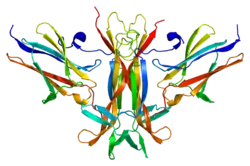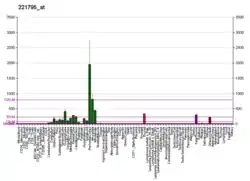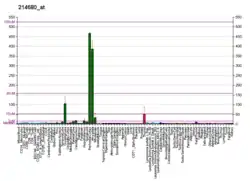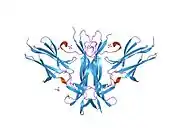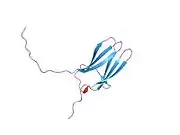Tropomyosin receptor kinase B
Tropomyosin receptor kinase B (TrkB),[5] also known as tyrosine receptor kinase B,[5] or BDNF/NT-3 growth factors receptor or neurotrophic tyrosine kinase, receptor, type 2 is a protein that in humans is encoded by the NTRK2 gene.[5][6] TrkB is a receptor for brain-derived neurotrophic factor (BDNF).
Function
Tropomyosin receptor kinase B is the high affinity catalytic receptor for several "neurotrophins", which are small protein growth factors that induce the survival and differentiation of distinct cell populations. The neurotrophins that activate TrkB are: BDNF (Brain Derived Neurotrophic Factor), neurotrophin-4 (NT-4), and neurotrophin-3 (NT-3).[5] As such, TrkB mediates the multiple effects of these neurotrophic factors, which includes neuronal differentiation and survival. Research has shown that activation of the TrkB receptor can lead to down regulation of the KCC2 chloride transporter in cells of the CNS.[7]
The TrkB receptor is part of the large family of receptor tyrosine kinases. A "tyrosine kinase" is an enzyme which is capable of adding a phosphate group to certain tyrosines on target proteins, or "substrates". A receptor tyrosine kinase is a "tyrosine kinase" which is located at the cellular membrane, and is activated by binding of a ligand to the receptor's extracellular domain. Other examples of tyrosine kinase receptors include the insulin receptor, the IGF1 receptor, the MuSK protein receptor, the Vascular Endothelial Growth Factor (or VEGF) receptor, etc.

Currently, there are three TrkB isoforms in the mammalian CNS. The full-length isoform (TK+) is a typical tyrosine kinase receptor, and transduces the BDNF signal via Ras-ERK, PI3K, and PLCγ. In contrast, two truncated isoforms (TK-: T1 and T2) possess the same extracellular domain, transmembrane domain, and first 12 intracellular amino acid sequences as TK+. However, the C-terminal sequences are the isoform-specific (11 and 9 amino acids, respectively). T1 has the original signaling cascade that is involved in the regulation of cell morphology and calcium influx.
Family members
TrkB is part of a sub-family of protein kinases which includes also TrkA and TrkC. There are other neurotrophic factors structurally related to BDNF: NGF (for Nerve Growth Factor), NT-3 (for Neurotrophin-3) and NT-4 (for Neurotrophin-4). While TrkB mediates the effects of BDNF, NT-4 and NT-3, TrkA is bound and thereby activated only by NGF. Further, TrkC binds and is activated by NT-3.
TrkB binds BDNF and NT-4 more strongly than it binds NT-3. TrkC binds NT-3 more strongly than TrkB does.
LNGFR
There is one other BDNF receptor besides TrkB, called the "LNGFR" (for "low-affinity nerve growth factor receptor"). Unlike TrkB, the LNGFR plays a somewhat less clear role in BDNF biology. Some researchers have shown the LNGFR binds and serves as a "sink" for neurotrophins. Cells which express both the LNGFR and the Trk receptors might therefore have a greater activity – since they have a higher "microconcentration" of the neurotrophin. It has also been shown, however, that the LNGFR may signal a cell to die via apoptosis – so therefore cells expressing the LNGFR in the absence of Trk receptors may die rather than live in the presence of a neurotrophin.
Role in cancer
Although originally identified as an oncogenic fusion in 1982,[8] only recently has there been a renewed interest in the Trk family as it relates to its role in human cancers because of the identification of NTRK1 (TrkA), NTRK2 (TrkB) and NTRK3 (TrkC) gene fusions and other oncogenic alterations in a number of tumor types. A number of Trk inhibitors are (in 2015) in clinical trials and have shown early promise in shrinking human tumors.[9]
As a drug target
Entrectinib (formerly RXDX-101) is an investigational drug developed by Ignyta, Inc., which has potential antitumor activity. It is a selective pan-trk receptor tyrosine kinase inhibitor (TKI) targeting gene fusions in trkA, trkB (this gene), and trkC (respectively, coded by NTRK1, NTRK2, and NTRK3 genes) that is currently in phase 2 clinical testing.[10]
Ligands
Agonists
- 3,7-Dihydroxyflavone
- 3,7,8,2'-Tetrahydroxyflavone
- 4'-Dimethylamino-7,8-dihydroxyflavone (4'-DMA-7,8-DHF, eutropoflavin)[11]
- 7,3′-Dihydroxyflavone
- 7,8-Dihydroxyflavone (7,8-DHF, tropoflavin)
- 7,8,2'-Trihydroxyflavone
- 7,8,3'-Trihydroxyflavone
- Amitriptyline[12]
- BNN-20[13]
- Brain-derived neurotrophic factor (BDNF)
- Deoxygedunin[14]
- Deprenyl
- Diosmetin
- DMAQ-B1
- HIOC
- LM22A-4
- N-Acetylserotonin (NAS)
- Neurotrophin-3 (NT-3)
- Neurotrophin-4 (NT-4)
- Norwogonin (5,7,8-THF)
- R7 (prodrug of 7,8-DHF)[15]
- R13 (prodrug of 7,8-DHF)[16]
- TDP6
Antagonists
- ANA-12
- Cyclotraxin B
- Gossypetin (3,5,7,8,3',4'-HHF)
Others
Interactions
TrkB has been shown to interact with:
See also
References
- GRCh38: Ensembl release 89: ENSG00000148053 - Ensembl, May 2017
- GRCm38: Ensembl release 89: ENSMUSG00000055254 - Ensembl, May 2017
- "Human PubMed Reference:". National Center for Biotechnology Information, U.S. National Library of Medicine.
- "Mouse PubMed Reference:". National Center for Biotechnology Information, U.S. National Library of Medicine.
- Malenka RC, Nestler EJ, Hyman SE (2009). "Chapter 8: Atypical neurotransmitters". In Sydor A, Brown RY (eds.). Molecular Neuropharmacology: A Foundation for Clinical Neuroscience (2nd ed.). New York: McGraw-Hill Medical. ISBN 9780071481274.
Another common feature of neurotrophins is that they produce their physiologic effects by means of the tropomyosin receptor kinase (Trk) receptor family (also known as the tyrosine receptor kinase family). ...Trk receptors All neurotrophins bind to a class of highly homologous receptor tyrosine kinases known as Trk receptors, of which three types are known: TrkA, TrkB, and TrkC. These transmembrane receptors are glycoproteins whose molecular masses range from 140 to 145 kDa. Each type of Trk receptor tends to bind specific neurotrophins: TrkA is the receptor for NGF, TrkB the receptor for BDNF and NT-4, and TrkC the receptor for NT-3.However, some overlap in the specificity of these receptors has been noted.
- Nakagawara A, Liu XG, Ikegaki N, White PS, Yamashiro DJ, Nycum LM, Biegel JA, Brodeur GM (January 1995). "Cloning and chromosomal localization of the human TRK-B tyrosine kinase receptor gene (NTRK2)". Genomics. 25 (2): 538–46. doi:10.1016/0888-7543(95)80055-Q. PMID 7789988.
- "BDNF-induced TrkB activation down-regulates the K+-Cl- cotransporter KCC2 and impairs neuronal Cl- extrusion". PMC 2173387.
- Pulciani S, Santos E, Lauver AV, Long LK, Aaronson SA, Barbacid M (December 1982). "Oncogenes in solid human tumours". Nature. 300 (5892): 539–42. Bibcode:1982Natur.300..539P. doi:10.1038/300539a0. PMID 7144906. S2CID 30179526.
- Doebele RC, Davis LE, Vaishnavi A, Le AT, Estrada-Bernal A, Keysar S, Jimeno A, Varella-Garcia M, Aisner DL, Li Y, Stephens PJ, Morosini D, Tuch BB, Fernandes M, Nanda N, Low JA (October 2015). "An Oncogenic NTRK Fusion in a Patient with Soft-Tissue Sarcoma with Response to the Tropomyosin-Related Kinase Inhibitor LOXO-101". Cancer Discovery. 5 (10): 1049–57. doi:10.1158/2159-8290.CD-15-0443. PMC 4635026. PMID 26216294.
- "Promising entrectinib clinical trial data". ScienceDaily. 18 April 2016.
- Liu X, Chan CB, Jang SW, Pradoldej S, Huang J, He K, Phun LH, France S, Xiao G, Jia Y, Luo HR, Ye K (November 2010). "A synthetic 7,8-dihydroxyflavone derivative promotes neurogenesis and exhibits potent antidepressant effect". J. Med. Chem. 53 (23): 8274–86. doi:10.1021/jm101206p. PMC 3150605. PMID 21073191.
- Jang SW, Liu X, Chan CB, Weinshenker D, Hall RA, Xiao G, Ye K (2009). "Amitriptyline is a TrkA and TrkB receptor agonist that promotes TrkA/TrkB heterodimerization and has potent neurotrophic activity". Chem. Biol. 16 (6): 644–56. doi:10.1016/j.chembiol.2009.05.010. PMC 2844702. PMID 19549602.
- Lazaridis I, Charalampopoulos I, Alexaki VI, Avlonitis N, Pediaditakis I, Efstathopoulos P, Calogeropoulou T, Castanas E, Gravanis A (2011). "Neurosteroid dehydroepiandrosterone interacts with nerve growth factor (NGF) receptors, preventing neuronal apoptosis". PLOS Biol. 9 (4): e1001051. doi:10.1371/journal.pbio.1001051. PMC 3082517. PMID 21541365.
- Jang SW, Liu X, Chan CB, France SA, Sayeed I, Tang W, Lin X, Xiao G, Andero R, Chang Q, Ressler KJ, Ye K (2010). "Deoxygedunin, a natural product with potent neurotrophic activity in mice". PLOS ONE. 5 (7): e11528. Bibcode:2010PLoSO...511528J. doi:10.1371/journal.pone.0011528. PMC 2903477. PMID 20644624.
- Liu C, Chan CB, Ye K (2016). "7,8-dihydroxyflavone, a small molecular TrkB agonist, is useful for treating various BDNF-implicated human disorders". Transl Neurodegener. 5: 2. doi:10.1186/s40035-015-0048-7. PMC 4702337. PMID 26740873.
- Chen C, Wang Z, Zhang Z, Liu X, Kang SS, Zhang Y, Ye K (January 2018). "The prodrug of 7,8-dihydroxyflavone development and therapeutic efficacy for treating Alzheimer's disease". Proc. Natl. Acad. Sci. U.S.A. 115 (3): 578–583. doi:10.1073/pnas.1718683115. PMC 5777001. PMID 29295929.
- Prough RA, Clark BJ, Klinge CM (2016). "Novel mechanisms for DHEA action". J. Mol. Endocrinol. 56 (3): R139–55. doi:10.1530/JME-16-0013. PMID 26908835.
- Pediaditakis I, Iliopoulos I, Theologidis I, Delivanoglou N, Margioris AN, Charalampopoulos I, Gravanis A (2015). "Dehydroepiandrosterone: an ancestral ligand of neurotrophin receptors". Endocrinology. 156 (1): 16–23. doi:10.1210/en.2014-1596. PMID 25330101.
- Haniu M, Montestruque S, Bures EJ, Talvenheimo J, Toso R, Lewis-Sandy S, Welcher AA, Rohde MF (October 1997). "Interactions between brain-derived neurotrophic factor and the TRKB receptor. Identification of two ligand binding domains in soluble TRKB by affinity separation and chemical cross-linking". J. Biol. Chem. 272 (40): 25296–303. doi:10.1074/jbc.272.40.25296. PMID 9312147.
- Naylor RL, Robertson AG, Allen SJ, Sessions RB, Clarke AR, Mason GG, Burston JJ, Tyler SJ, Wilcock GK, Dawbarn D (March 2002). "A discrete domain of the human TrkB receptor defines the binding sites for BDNF and NT-4". Biochem. Biophys. Res. Commun. 291 (3): 501–7. doi:10.1006/bbrc.2002.6468. PMID 11855816.
- Iwasaki Y, Gay B, Wada K, Koizumi S (July 1998). "Association of the Src family tyrosine kinase Fyn with TrkB". J. Neurochem. 71 (1): 106–11. doi:10.1046/j.1471-4159.1998.71010106.x. PMID 9648856. S2CID 9012343.
- Suzuki S, Mizutani M, Suzuki K, Yamada M, Kojima M, Hatanaka H, Koizumi S (June 2002). "Brain-derived neurotrophic factor promotes interaction of the Nck2 adaptor protein with the TrkB tyrosine kinase receptor". Biochem. Biophys. Res. Commun. 294 (5): 1087–92. doi:10.1016/S0006-291X(02)00606-X. PMID 12074588.
- Meakin SO, MacDonald JI, Gryz EA, Kubu CJ, Verdi JM (April 1999). "The signaling adapter FRS-2 competes with Shc for binding to the nerve growth factor receptor TrkA. A model for discriminating proliferation and differentiation". J. Biol. Chem. 274 (14): 9861–70. doi:10.1074/jbc.274.14.9861. PMID 10092678.
- Geetha T, Wooten MW (February 2003). "Association of the atypical protein kinase C-interacting protein p62/ZIP with nerve growth factor receptor TrkA regulates receptor trafficking and Erk5 signaling". J. Biol. Chem. 278 (7): 4730–9. doi:10.1074/jbc.M208468200. PMID 12471037.
- Nakamura T, Muraoka S, Sanokawa R, Mori N (March 1998). "N-Shc and Sck, two neuronally expressed Shc adapter homologs. Their differential regional expression in the brain and roles in neurotrophin and Src signaling". J. Biol. Chem. 273 (12): 6960–7. doi:10.1074/jbc.273.12.6960. PMID 9507002.
Further reading
- Klein R, Conway D, Parada LF, Barbacid M (May 1990). "The trkB tyrosine protein kinase gene codes for a second neurogenic receptor that lacks the catalytic kinase domain". Cell. 61 (4): 647–56. doi:10.1016/0092-8674(90)90476-U. PMID 2160854. S2CID 205020147.
- Squinto SP, Stitt TN, Aldrich TH, Davis S, Bianco SM, Radziejewski C, Glass DJ, Masiakowski P, Furth ME, Valenzuela DM (May 1991). "trkB encodes a functional receptor for brain-derived neurotrophic factor and neurotrophin-3 but not nerve growth factor". Cell. 65 (5): 885–93. doi:10.1016/0092-8674(91)90395-F. PMID 1710174. S2CID 28853455.
- Rose CR, Blum R, Pichler B, Lepier A, Kafitz KW, Konnerth A (November 2003). "Truncated TrkB-T1 mediates neurotrophin-evoked calcium signalling in glia cells". Nature. 426 (6962): 74–8. Bibcode:2003Natur.426...74R. doi:10.1038/nature01983. PMID 14603320. S2CID 4432074.
- Ohira K, Kumanogoh H, Sahara Y, Homma KJ, Hirai H, Nakamura S, Hayashi M (February 2005). "A truncated tropomyosin-related kinase B receptor, T1, regulates glial cell morphology via Rho GDP dissociation inhibitor 1". J. Neurosci. 25 (6): 1343–53. doi:10.1523/JNEUROSCI.4436-04.2005. PMC 6725989. PMID 15703388.
- Yamada K, Nabeshima T (2003). "Brain-derived neurotrophic factor/TrkB signaling in memory processes". J. Pharmacol. Sci. 91 (4): 267–70. doi:10.1254/jphs.91.267. PMID 12719654.
- Soppet D, Escandon E, Maragos J, Middlemas DS, Reid SW, Blair J, Burton LE, Stanton BR, Kaplan DR, Hunter T, Nikolics K, Parada LF (1991). "The neurotrophic factors brain-derived neurotrophic factor and neurotrophin-3 are ligands for the trkB tyrosine kinase receptor". Cell. 65 (5): 895–903. doi:10.1016/0092-8674(91)90396-G. PMID 1645620. S2CID 37843818.
- Squinto SP, Stitt TN, Aldrich TH, Davis S, Bianco SM, Radziejewski C, Glass DJ, Masiakowski P, Furth ME, Valenzuela DM (1991). "trkB encodes a functional receptor for brain-derived neurotrophic factor and neurotrophin-3 but not nerve growth factor". Cell. 65 (5): 885–93. doi:10.1016/0092-8674(91)90395-F. PMID 1710174. S2CID 28853455.
- Haniu M, Talvenheimo J, Le J, Katta V, Welcher A, Rohde MF (1995). "Extracellular domain of neurotrophin receptor trkB: disulfide structure, N-glycosylation sites, and ligand binding". Arch. Biochem. Biophys. 322 (1): 256–64. doi:10.1006/abbi.1995.1460. PMID 7574684.
- Ip NY, Stitt TN, Tapley P, Klein R, Glass DJ, Fandl J, Greene LA, Barbacid M, Yancopoulos GD (1993). "Similarities and differences in the way neurotrophins interact with the Trk receptors in neuronal and nonneuronal cells". Neuron. 10 (2): 137–49. doi:10.1016/0896-6273(93)90306-C. PMID 7679912. S2CID 46072027.
- Slaugenhaupt SA, Blumenfeld A, Liebert CB, Mull J, Lucente DE, Monahan M, Breakefield XO, Maayan C, Parada L, Axelrod FB (1995). "The human gene for neurotrophic tyrosine kinase receptor type 2 (NTRK2) is located on chromosome 9 but is not the familial dysautonomia gene". Genomics. 25 (3): 730–2. doi:10.1016/0888-7543(95)80019-I. PMID 7759111.
- Shelton DL, Sutherland J, Gripp J, Camerato T, Armanini MP, Phillips HS, Carroll K, Spencer SD, Levinson AD (1995). "Human trks: molecular cloning, tissue distribution, and expression of extracellular domain immunoadhesins". J. Neurosci. 15 (1 Pt 2): 477–91. doi:10.1523/JNEUROSCI.15-01-00477.1995. PMC 6578290. PMID 7823156.
- Allen SJ, Dawbarn D, Eckford SD, Wilcock GK, Ashcroft M, Colebrook SM, Feeney R, MacGowan SH (1994). "Cloning of a non-catalytic form of human trkB and distribution of messenger RNA for trkB in human brain". Neuroscience. 60 (3): 825–34. doi:10.1016/0306-4522(94)90507-X. PMID 7936202. S2CID 29288978.
- Rydén M, Ibáñez CF (1996). "Binding of neurotrophin-3 to p75LNGFR, TrkA, and TrkB mediated by a single functional epitope distinct from that recognized by trkC". J. Biol. Chem. 271 (10): 5623–7. doi:10.1074/jbc.271.10.5623. PMID 8621424.
- Yamamoto M, Sobue G, Yamamoto K, Terao S, Mitsuma T (1996). "Expression of mRNAs for neurotrophic factors (NGF, BDNF, NT-3, and GDNF) and their receptors (p75NGFR, trkA, trkB, and trkC) in the adult human peripheral nervous system and nonneural tissues". Neurochem. Res. 21 (8): 929–38. doi:10.1007/BF02532343. PMID 8895847. S2CID 20559271.
- Valent A, Danglot G, Bernheim A (1997). "Mapping of the tyrosine kinase receptors trkA (NTRK1), trkB (NTRK2) and trkC(NTRK3) to human chromosomes 1q22, 9q22 and 15q25 by fluorescence in situ hybridization". Eur. J. Hum. Genet. 5 (2): 102–4. doi:10.1159/000484742. PMID 9195161.
- Haniu M, Montestruque S, Bures EJ, Talvenheimo J, Toso R, Lewis-Sandy S, Welcher AA, Rohde MF (1997). "Interactions between brain-derived neurotrophic factor and the TRKB receptor. Identification of two ligand binding domains in soluble TRKB by affinity separation and chemical cross-linking". J. Biol. Chem. 272 (40): 25296–303. doi:10.1074/jbc.272.40.25296. PMID 9312147.
- Nakamura T, Muraoka S, Sanokawa R, Mori N (1998). "N-Shc and Sck, two neuronally expressed Shc adapter homologs. Their differential regional expression in the brain and roles in neurotrophin and Src signaling". J. Biol. Chem. 273 (12): 6960–7. doi:10.1074/jbc.273.12.6960. PMID 9507002.
- Hackett SF, Friedman Z, Freund J, Schoenfeld C, Curtis R, DiStefano PS, Campochiaro PA (1998). "A splice variant of trkB and brain-derived neurotrophic factor are co-expressed in retinal pigmented epithelial cells and promote differentiated characteristics". Brain Res. 789 (2): 201–12. doi:10.1016/S0006-8993(97)01440-6. PMID 9573364. S2CID 1814445.
- Iwasaki Y, Gay B, Wada K, Koizumi S (1998). "Association of the Src family tyrosine kinase Fyn with TrkB". J. Neurochem. 71 (1): 106–11. doi:10.1046/j.1471-4159.1998.71010106.x. PMID 9648856. S2CID 9012343.
- Qian X, Riccio A, Zhang Y, Ginty DD (1998). "Identification and characterization of novel substrates of Trk receptors in developing neurons". Neuron. 21 (5): 1017–29. doi:10.1016/S0896-6273(00)80620-0. PMID 9856458. S2CID 12354383.
- Bibel M, Hoppe E, Barde YA (1999). "Biochemical and functional interactions between the neurotrophin receptors trk and p75NTR". EMBO J. 18 (3): 616–22. doi:10.1093/emboj/18.3.616. PMC 1171154. PMID 9927421.
- Yamada M, Ohnishi H, Sano S, Araki T, Nakatani A, Ikeuchi T, Hatanaka H (1999). "Brain-derived neurotrophic factor stimulates interactions of Shp2 with phosphatidylinositol 3-kinase and Grb2 in cultured cerebral cortical neurons". J. Neurochem. 73 (1): 41–9. doi:10.1046/j.1471-4159.1999.0730041.x. PMID 10386953. S2CID 25333848.
- Ultsch MH, Wiesmann C, Simmons LC, Henrich J, Yang M, Reilly D, Bass SH, de Vos AM (1999). "Crystal structures of the neurotrophin-binding domain of TrkA, TrkB and TrkC". J. Mol. Biol. 290 (1): 149–59. doi:10.1006/jmbi.1999.2816. PMID 10388563.
External links
- Memories are made of this molecule - New Scientist, 15 January 2007.
